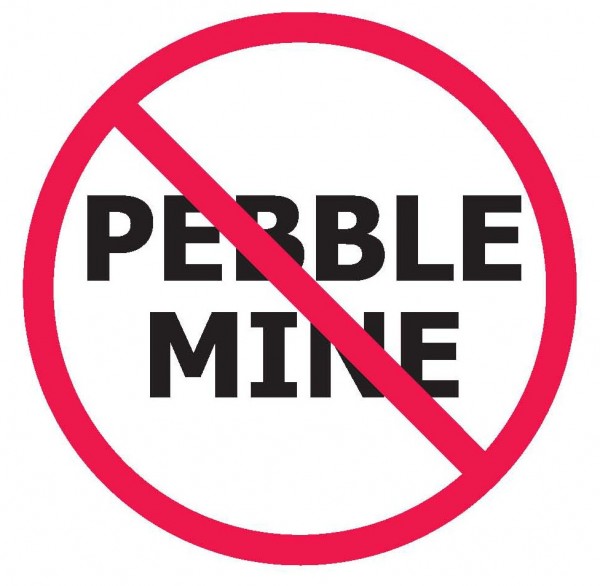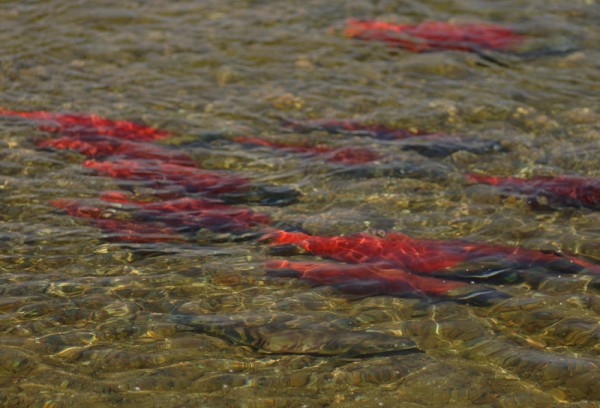Background
[dropcap]T[/dropcap]he Pebble deposit is a massive storehouse of gold, copper and molybdemum, located in the headwaters of the Kvichak and Nushagak Rivers, two of the eight major rivers that feed Bristol Bay. If built, Pebble would be one of the largest mines in the world. Because of its size, geochemistry and location, Pebble runs a high risk of polluting Bristol Bay entirely one of the world’s few and most productive wild salmon strongholds that supports a $500 million commercial and sport fishery. For this reason, Trout Unlimited is working with a diverse group of fishermen, guides, lodge owners, Alaska Natives, scientists, chef, restaurant owners, seafood lovers and many others to try to stop the Pebble development and to protect Bristol Bay.The proposed mine developers, the Pebble Limited Partnership (PLP) are a consortium of the world’s second largest multinational mining corporation, London-based Anglo American, along with Northern Dynasty, a junior mining company headquartered in Canada. Anglo American’s environmental track record does not bode well for Bristol Bay and Northern Dynasty has little experience safeguarding the environment having never developed a mine to date. Although PLP has not released its final mine plans, preliminary designs indicate that the Pebble Mine complex would span 20 square miles of state land in the Bristol Bay watershed. Located in a seismically active region, Pebble would require the world’s largest earthen dam to be built, some 700 feet high and several miles in length.
Independent scientists have questioned whether the dam could withstand the force of a massive earthquake, such as the 9.2 quake that devastated Anchorage in 1964.
The dam and 10-square-mile-wide containment pond are intended to hold between 2.5 billion and 10 billion tons of mine waste that Pebble would produce over its lifetime – nearly enough to bury the city of Seattle, Washington. Because the sulfide, or acid-generating, nature of the Pebble ore body, the waste would require environmental treatment in perpetuity. Any release of mine waste into the surface or groundwater has the potential to harm Bristol Bay’s salmon runs.
The PLP recently stated that they plan to apply for federal and state permits in spring of 2011. With the developers moving toward permitting, now is the time to get involved to stop this mega-project and protect Bristol Bay. Now is the time to educate elected officials, agency heads, the media and anyone who cares about the future of wild salmon. [Read More]
EPA comes to help; Pebble advocates attack
By BELLA HAMMOND
With all the news and commotion about the Environmental Protection Agency study of the Bristol Bay Watershed and potential massive-scale mining in the area, some important points need to be considered. I am personally very thankful for the efforts of the EPA in listening to the overwhelming majority of Bristol Bay residents who requested protection of our watershed. EPA’s studies are at our request because our own state government has ignored, minimized or swept under the rug years of water violations, fuel spills, wetlands abuse and drilling violations.
I have tried to listen well to the science and professional people discussing the Pebble prospect over the past eight or 10 years. None of the people I have talked to believe this deposit in this location can be developed under any plan without seriously damaging our fishery, land, water, environment or way of life.
The most recent EPA process, the peer review of the watershed assessment, was supposed to be about science. The mine advocates had very little science but many attacks for EPA, who came to help us. The panel’s 12 independent science professionals supported the watershed assessment and pointed out additional reasons that EPA’s review is likely a conservative underestimate of the probable negative impacts of massive mine development in the watershed. Even some of the reviewers seemed at times sucked into the repeated political opinions.
I am not amused by political double talk. How can Pebble tell us they have no plan when they have used a detailed plan since 2006 to hold priority for rights to all of the water in the mine area? They have paid for and filed with stock market regulators multiple detailed plans and they have told their shareholders they have 10.8 billion tons of mineable ore. Are they telling the truth to their shareholders, the regulators, or to us?
Now we read and hear about Outside congressmen from California and Georgia attacking and threatening EPA for listening to us. We are dependent on salmon and clean water for every part of our life, culture and economy. We are very afraid of these foreign corporations and their influence on our government.
Our area legislators — Senate President Gary Stevens, Senate Finance Co-chair Lyman Hoffman, House Majority Leader Alan Austerman and Rep. Bryce Edgmon — all joined us in asking for and supporting EPA action to protect Bristol Bay. I guess it shouldn’t be a surprise that other politicians from far away are willing to risk our fisheries and the 14,000 jobs that depend on them for a few short-term jobs or political rhetoric.
Again, thank you, EPA, from the majority of Alaskans, from the overwhelming majority of Bristol Bay residents, from the unanimous legislative delegation from Bristol Bay and from people all over the world who are learning how very much is at stake here.
I have tried to listen well to the science and professional people discussing the Pebble prospect over the past eight or ten years. None of the people I have talked to believe this deposit in this location can be developed under any plan without seriously damaging our fishery, land, water, environment or way of life.
The most recent EPA process, the peer review of the watershed assessment, was supposed to be about science. The mine advocates had very little science but many attacks for EPA, who came to help us. The panel’s 12 independent science professionals supported the watershed assessment and pointed out additional reasons that EPA’s review is likely a conservative underestimate of the probable negative impacts of massive mine development in the watershed. Even some of the reviewers seemed at times sucked into the repeated political opinions.
I am not amused by political double talk. How can Pebble tell us they have no plan when they have used a detailed plan since 2006 to hold priority for rights to all of the water in the mine area? They have paid for and filed with stock market regulators multiple detailed plans and they have told their shareholders they have 10.8 billion tons of mineable ore. Are they telling the truth to their shareholders, the regulators, or to us?
Now we read and hear about Outside congressmen from California and Georgia attacking and threatening EPA for listening to us. We are dependent on salmon and clean water for every part of our life, culture and economy. We are very afraid of these foreign corporations and their influence on our government.
Our area legislators — Senate President Gary Stevens, Senate Finance Co-chair Lyman Hoffman, House Majority Leader Alan Austerman and Rep. Bryce Edgmon — all joined us in asking for and supporting EPA action to protect Bristol Bay. I guess it shouldn’t be a surprise that other politicians from far away are willing to risk our fisheries and the 14,000 jobs that depend on them for a few short-term jobs or political rhetoric.
Again, thank you, EPA, from the majority of Alaskans, from the overwhelming majority of Bristol Bay residents, from the unanimous legislative delegation from Bristol Bay and from people all over the world who are learning how very much is at stake here.
[information]Bella Hammond is a former first lady of Alaska, wife of Gov. Jay Hammond. Born and raised in Bristol Bay, she lives on Lake Clark in the family home.
[/information]




